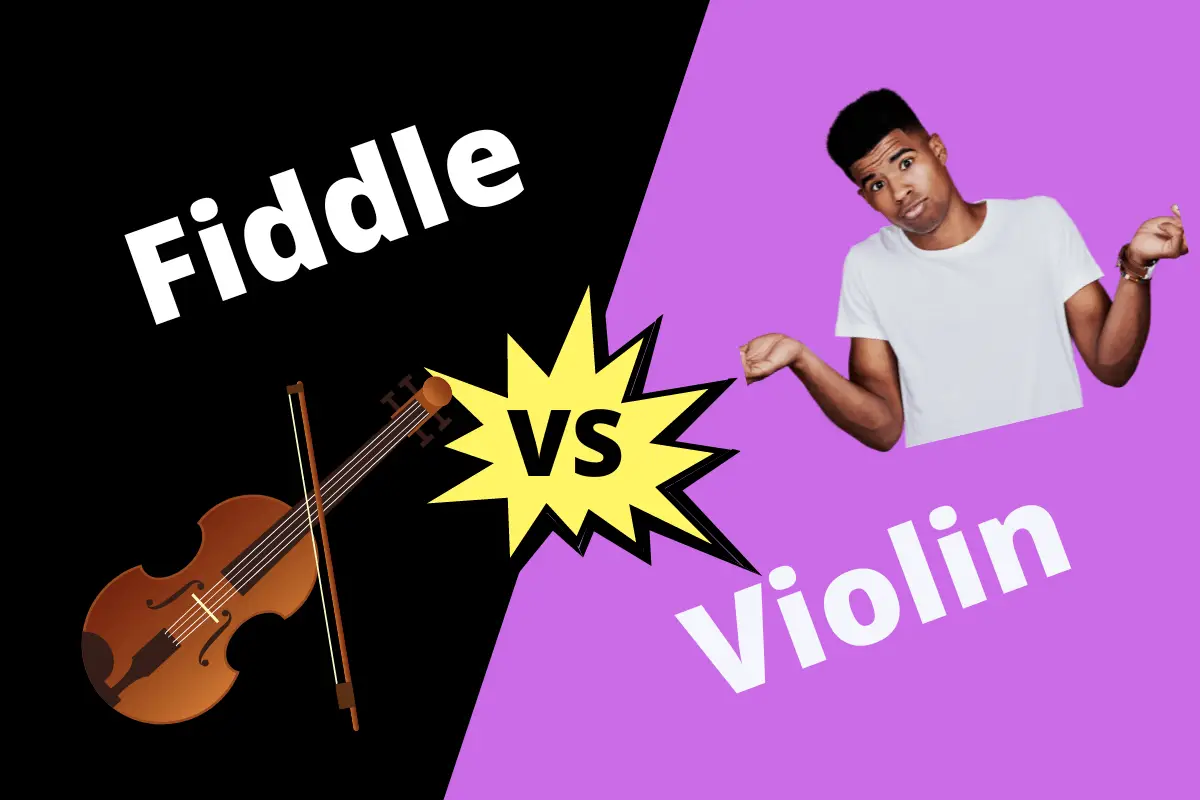The key difference between a fiddle and a violin is their use. While a fiddle is used for music genres such as cajun, country, folk, and bluegrass, a violin is used mainly for classical music.
If you see a violin and a fiddle side by side, it might not be obvious which one is which because both are the same instrument but with different playing styles.
Knowing the difference between the two instruments will increase your knowledge if you are a music enthusiast.
Table of Contents
Difference Between Fiddle and Violin
| Fiddle | vs | Violin |
| Steel or synthetic core | Materials Of String | Synthetic core |
| Bluegrass, folk, country, jazz, and electric fiddle | Music Genre | Folk, classical, jazz, and country |
| The bridge may be more flat to allow for double and triple stop bowing | Bridge | The bridge is more arched for cleaner single noting |
| Long | Bow Size | Short |
| G3, D4, A4, E5, and C3 | Tunings of Strings | G3, D4, A4, and E5 |
| The fiddle combines various instruments, including drums, electronic keyboards, banjo, mandolin, and guitar. | Accompanying Instruments | A violin accompanies cellos, violas, symphonic horns, and double basses |
| Chin rest is a separate piece mounted using a tricky screwing mechanism | Parts And Construction | Chin rest is a part of the tailpiece |
What is a Fiddle?
A fiddle is a colloquial term for the violin used in traditional classical music. It belongs to the violin family, meaning that it’s a bowed string instrument that emerged in 10th-century Europe, deriving from the Byzantine lira.
In the medieval era, the fiddle was referred to as the predecessor of today’s violin. It has four strings and is available in various shapes and sizes.
Fiddles often have a flatter bridge, which brings the strings closer to the fingerboard, making fiddle techniques, such as rapid string crossings and chording, more manageable.
Fiddle playing is determined by a large variety of ethnic or folk music. Each subgenre has its distinctive sound. The individuals who love playing a fiddle are termed “fiddlers.”

Common Music Genres
The common music genres for a fiddle are:
- Bluegrass
- Appalachian music
- Horn pipe
- Cajun music
- String band
- Hoedown
- Old time fiddle
- Old time music
- Western swing
- Cape Breton fiddling
- Music of Ireland
- Irish traditional music
What is a Violin?
The violin is the most iconic smallest string instrument that produces a high-pitched sound. It has four strings, tuned in 5ths: G3, D4, A4, E5, and a hollow wooden body.
The violin string was initially made from sheep gut, but now, steel strings are used. Violin is generally played by drawing a bow across its strings, plucking the strings with the fingers, or striking the strings with the wooden side of the bow.
Violins are used for various musical styles, such as folk music, bluegrass music, jazz, or country music, but are more prominent for western classical. The violin was first introduced in the 16th century in Italy.
A violinist tucks the instrument between their chin and shoulder and uses their right hand to bow and left hand to sound notes on the fingerboard.

Common Music Genres
The common music genres for violin are:
- Classical music
- Romani music
- Sonata
- Chamber music
- Klezmer
- Music of Ireland
- Carnatic music
- Baroque music
Classical Violinist Itzhak Perlman
Itzhak Perlman is a legendary Israeli-American classical violinist. He is known for his brilliant virtuoso technique. His elegance while playing the violin led many to respect him as the finest violinist in the major violin repertoire of his time.
Violin vs. Fiddle – Key Differences
Here is the brief differentiation between these two stringed instruments.
String Material
In a fiddle, the string is made up of a synthetic or steel core, whereas in a violin, the string is made up of a synthetic core.
You can play a double stop on a violin by simultaneously striking the two adjacent strings with the bow. Similarly, you can play a triple stop by striking three adjacent strings with the bow.
Music Genres
The fiddle is often employed for music genres such as bluegrass (a style of music,) folk country, jazz, and electric fiddle.
In contrast, a violin is used for music genres such as folk, classical, jazz, and country.
Bridge
For a fiddle, the bridge is flatter (or less of an arc), which allows for double and triple stop bowing. In a violin, there is an arched bridge for cleaner single notes.
Bow Size
The bow of a fiddle is slightly longer than that of the violin.
String Tuning
Fiddle strings are tuned G3, D4, A4, E5, and an additional C3, almost similar to a violin. However, the violin strings are tuned to only G3, D4, A4, and E5.
Accompanying Instruments
A violin accompanies cellos, violas, symphonic horns, and double basses.
In contrast, the fiddle combines various instruments, including drums, electronic keyboards, banjo, mandolin, and guitar.
Parts and Construction
The chin rest is a separate piece mounted using a tricky screwing mechanism in the fiddle. On the other hand, in a violin, the chin rest is a part of the tailpiece.
Violin or Fiddle?
The key difference between the fiddle and violin is the music genre they are used for. While the violin plays classical music, the fiddle is used to play folk music.
Which instrument are you planning to master next – a violin or a fiddle?
If you’ve enjoyed reading this post, check out our blog comparing colleges versus universities.

